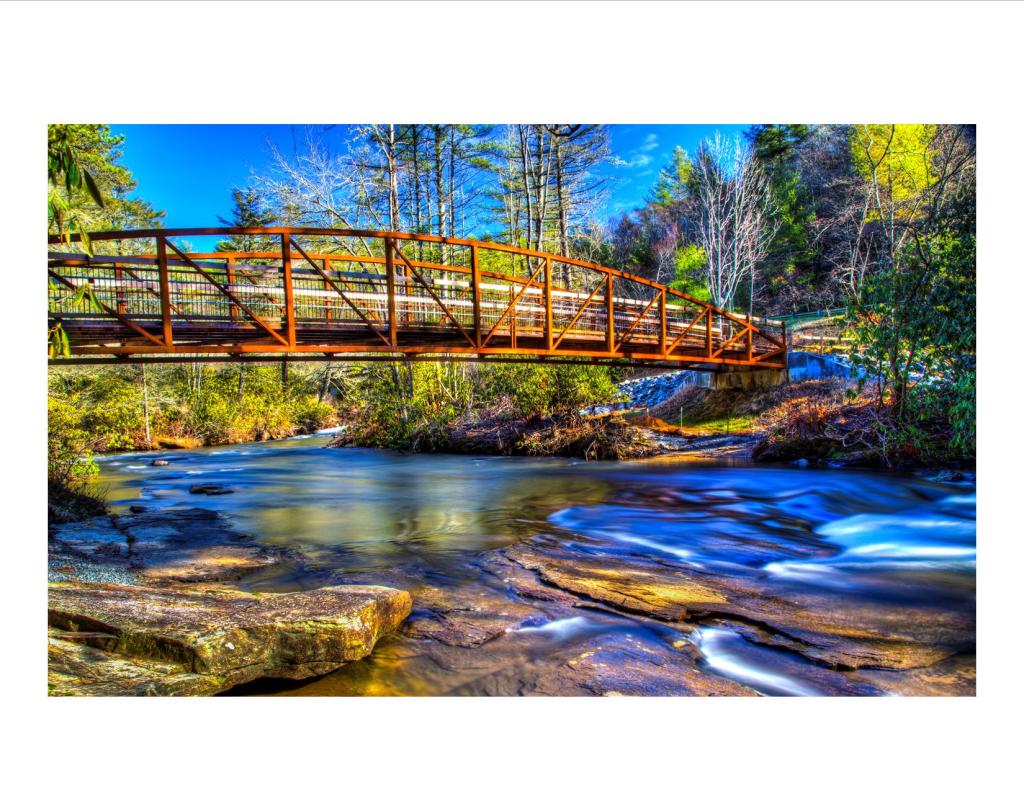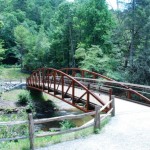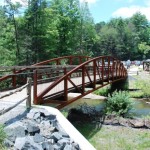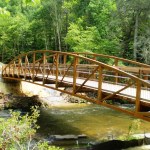
Mattern & Craig was selected to assist the DuPont State Forest in solving a long standing pedestrian and equestrian safety concern at the Forest’s popular Hooker Falls area. Traveling a very popular trail between Hooker Falls and Triple and High Falls required hikers to either ford the several foot deep, fast flowing Little River or to climb stairs and cross a very busy road that served as the main access to a large portion of the park. This route included climbing over guardrail on either side of the roadway. Due to the volume of traffic on the roadway, this route was becoming increasingly unsafe for the hikers. Horseback riders only option was to ford the Little River. This also presented a safety concern due to the slick rocks and swift current. The Forest staff had identified a location in the immediate vicinity of the existing ford that would be suitable for a bridge to serve both hikers and riders. Design criteria for the bridge included use by hikers and horseback riders and the occasional use by small all-terrain vehicles by Forest staff. A 10-foot wide bridge with rail height and a wooden deck designed to accommodate horses was selected.
The NC Forest Service is a unit of the NC Department of Agriculture (NCDA). The Secretary of Agriculture worked closely with the NC Department of Transportation (NCDOT) to acquire funding for this critical project. The project was considered a very high priority by the Secretary and emphasis was placed on having the bridge in service in time for a grand opening celebration for the Forest’s new visitor’s center in July, 2013. Mattern & Craig was brought into the project team in January, 2013 and asked to complete the design in an expedited fashion such that construction could be completed by the end of June, 2013.
Upon completion of the hydraulic study and bridge span determination, Mattern & Craig’s Structural Engineering department quickly selected a prefabricated bow truss bridge for the crossing. To accommodate the anticipated six week fabrication time for the bridge, Mattern & Craig suggested that the procurement and construction process be separated into two contracts. A contract for procurement of the prefabricated bridge would be let immediately while work continued on the structural design of the bridge abutments and the civil engineering design of related infrastructure including trail modifications to connect the existing trails to the proposed bridge, sediment and erosion control measures, and crane access to the project site for installation of the bridge. A construction contract for the site work and placement of the bridge would be subsequently let upon completion of the site specific design activities.
Contech http://www.conteches.com/ was selected by NCDOT through an accelerated procurement process. They fabricated and delivered the bridge on time and within budget. This arrangement worked well and the bridge was available for delivery to the site once the contractor had completed the abutments. The bridge was set in late June, remaining site work completed, and the bridge opened on the same day as the Forest’s new visitor center. The project was a complete success and the new bridge crossing has eliminated a significant safety concern in this very popular and busy area of the park.
Recent newsletter article: http://www.conteches.com/our-company/news/ctl/viewitem/mid/2784/itemid/293.aspx?skinsrc=/portals/_default/skins/r2icontechskin/toplevelskin



